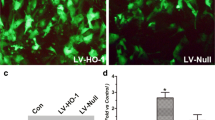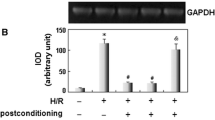Abstract
Neonatal rat cardiomyocytes were subjected to 24 h of hypoxia 95%N2/5%CO2 and 24 h of hypoxia plus 4 h of reoxygenation 95%O2/5%CO2. 24 h of hypoxia increased the levels of NO, NO2 -/NO3 -, TBARS and LDH. 24 h of hypoxia plus 4 h of reoxygenation decreased the levels of NO, NO2 -/NO3 -, but further increased TBARS and LDH. The hypoxia up-regulated the expression of bcl-2, p53 and p21/waf1/cip1 but the reoxygenation down-regulated the expression of bcl-2, and further up-regulated p53 and p21/waf1/cip1. The hypoxia increased cell apoptosis and reoxygenation further increased both apoptotic and necrotic cell death. NO, NO2/NO3 - TBARS, DNA fragmentation and cell apoptosis were enhanced by SNP and inhibited by L-NAME respectively. In addition, SOD/catalase down-regulated the expression of p53, p21/wafl/cipl and TBARS but up-regulated bcl-2 and increased indirectly the level of NO, NO2 -/NO3 -, and inhibited DNA fragmentation. The results suggest that hypoxia-induced cell death is associated with the activation of NO, bcl-2 and p53 pathway, while hypoxia-reoxygenation induced cell death via the generation of reactive oxygen species and activation of p53 pathway. The present study clarified that NO may be an initiative signal to apoptotic cell death and the activation of bcl-2, p53 and p21/waf1/cip1 pathway in hypoxic and hypoxia-reoxygenated cardiomyocytes.
Similar content being viewed by others
References
Mastrangelo, A. J., Betenbaugh, M., Overcoming apoptosis: new methods for improving protein-expression systems, TIBTECH, 1998, 16: 88–95.
Tanaka, M., Ito, H., Adachi, S. et al., Hypoxia induces apoptosis with enhanced expression of Fas antigen messenger RNA in cultured neonatal rat cardiocardiac myocytes, Circ. Res., 1994, 75(3): 426–433.
Gottlieb, R. A., Burleson, K. O., Kloner, R. A. et al., Reperfusion injury induces apoptosis in rabbit cardiocardiac myocytes, J. Clin. Invest., 1994, 94: 1621–1628.
Kajstura, J., Cheng, W., Reiss, K. et al., Apoptotic and necrotic myocyte cell deaths are independent contributing variables of infarct size in rats, Lab. Invest., 1996, 74(1): 86–107.
Meßmer, U. K., Ankarcrona, M., Nicotera, P. et al.,p53 expression in nitric oxide-induced apoptosis, FEBS Lett., 1994, 355: 23–26.
Meßmer, U. K., Reimer, D. M., Reed, J. C. et al., Nitric oxide induced ploy(ADP-ribose) polymerase cleavage in RAW 264.7 macrophage apoptosis is blocked bybcl-2, FEBS Lett., 1996, 384(2): 162–166.
Dimmeler, S., Zeiher, A. M., Nitric oxide and apoptosis: another paradigm for the double-edged role of nitric oxide, Nitric Oxide, 1997, 1(4): 275–281.
Moncada, S., Palmer, R. M. J., Higgs, E. A., Nitric oxide: physiology, pathology and pharmacology, Pharmaco. Rev., 1991, 43: 109–142.
Meßmer, U. K., Brune, B., Nitric oxide (NO) in apoptotic versus necroic RAW 264.7 macrophage cell death: the role of NO-donor exposure, NAD+ content, andp53 accumulation, Arch. Biochem. Biophys., 1996, 327(1): 1–10.
Brune, B., Meßmer, U. K., Sandau, K., The role of nitric oxide in cell injury, Toxic Lett., 1995, 82/83: 233–237.
Matheis, G., Sherman, M. P., Buckberg, G. D. et al., Role of L-arginine-nitric oxide pathway in myocardial reoxygen injury, Am. J. Physiol., 1992, 262: H616–620.
Marx, J., New link found betweenp53 and DNArepair, Science, 1994, 266: 1321–1322.
Hoffman, B., Liebermann, D. A., Molecular control of apoptosis: differentiation/growth arrest primary response genes, proto-oncogenes, and tumor suppressor genes as positive and negative modulators, Oncogene, 1994, 9: 1807–1812.
Long, X., Boluyt, M. O., Hipolito, M. L. et al.,p53 and the hypoxia-induced apoptosis of cultured neonatal rat cardiac cardiac myocytes, Clin. Invest., 1997, 99(11): 2635–2643.
Ohkawa, H., Ohishi, N., Yagi, K., Assay for lipid peroxides in animal tissues in animal tissues by thiobarbituric acid reaction, Anal. Biochem., 1979, 95: 351–358.
Kajstura, J., Mansukhani, M., Cheng, W. et al., Programmed cell death and the expression of the protooncogenebcl-2 in myocyte during postnatal maturation of the heart, Exp. Cell Res., 1995, 219: 110–121.
Melkova, Z., Lee, S. B., Rodriguez, D. et al.,Bcl-2 prevents nitric oxide-mediated apoptosis and poly(ADP-ribose) polymerase cleavage, FEBS Lett., 1997, 403(3): 273–278.
Krishenbaum, L. A., Moissac, D., Thebcl-2 gene product prevents programmed cell death of ventricular cardiac myocytes, Circulation, 1997, 96(5): 1580–1585.
Cheng, W., Kajstura, J., Nitahara, A. J. et al., Programmed myocyte cell death affects the viable myocardium after infarction in rats, Exp. Cell Res., 1996, 226: 316–327.
Misao, J., Hayakawa, Y., Ohno, M. et al., Expression ofbcl-2 protein, an inhibitor of apoptosis, and Bax, an accelerator of apoptosis in ventricular cardiac myocytes of human hearts with myocardial infarction, Circulation, 1996, 94(7): 1506–1512.
Kaneto, H., Fujii, J., Seo, H. G. et al., Apoptotic cell death trigger by nitric oxide in pancreatic β-cells, Diabetes, 1995, 44: 733–738.
Vermes, I., Haanen, C., Steffens-Nakken, H. et al., A novel assay for apoptosis flow cytometric detection of phosphatidylserine expression on early apoptotic cells using fluorescein labelled Annexin V, J. Immunol. Meth., 1995, 184: 39–51.
Ei-Deiry, W. S., Harper, J. W., O’Connor, P. M. et al., Waf1/cip1 is induced inp53-mediated G1 arrest and apoptosis, Canc. Res., 1994, 54: 1169–1174.
Steck, K., McDonnell, T., Sneige, N. et al., Flow cytometric analysis of apoptosis andbcl-2 in primary breast carcinomas: clinical and biological implications, Cytometry, 1996, 24: 116–122.
Zhang, D. L., Xiong, J., Hu, J. G. et al., Improved method to detect nitric oxide in biological system, Appl. Magn. Reson., 2001, 20: 345–356.
Yu, L., Gengaro, P. E., Niederberger, M. et al., Nitric oxide: a mediator in rat tubular hypoxia/reoxygenation injury, Proc. Natl. Acad. Sci. USA, 1994, 91: 1691.
Bialik, S., Geenen, D. L., Sasson, I. E. et al., Myocyte apoptosis during acute myocardial infarction in the mouse localizes to hypoxic regions but occurs independently ofp53, J. Clin. Invest., 1997, 100(6): 1363–1372.
Heockenbery, D. M., Oltvai, Z. N., Yin, X. -M. et al.,Bcl-2 functions in an antioxidant pathway to prevent apoptosis, Cell, 1993, 75: 241–251.
Van Engeland, M., Nieland, L. J. W., Ramaekers, F. C. S. et al., Annexin V-affinity assay: a review on an apoptosis detection system based on phosphatidylserine exposure, Cytometry, 1998, 31: 1–9.
Author information
Authors and Affiliations
Corresponding author
Rights and permissions
About this article
Cite this article
Shen, J., Qiu, X., Jiang, B. et al. Nitric oxide and oxygen radicals induced apoptosis via bcl-2 and p53 pathway in hypoxia-reoxygenated cardiomyocytes. Sci. China Ser. C.-Life Sci. 46, 28–39 (2003). https://doi.org/10.1007/BF03182682
Received:
Issue Date:
DOI: https://doi.org/10.1007/BF03182682




